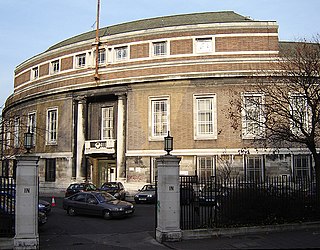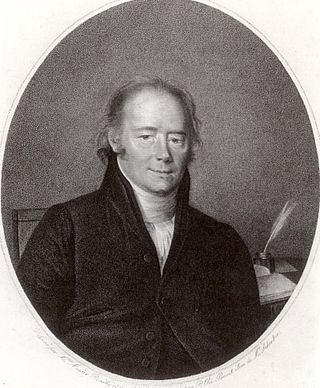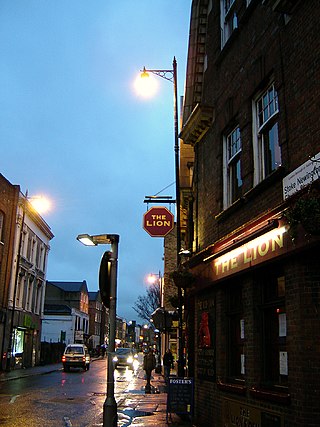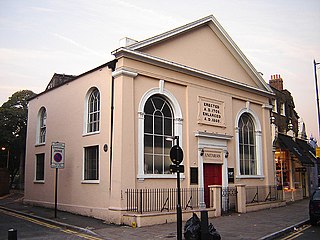
The London Borough of Hackney is a London borough in Inner London, England. The historical and administrative heart of Hackney is Mare Street, which lies 5 miles (8 km) north-east of Charing Cross. The borough is named after Hackney, its principal district. Southern and eastern parts of the borough are popularly regarded as being part of east London that spans some of the traditional East End of London with the northwest belonging to north London. Its population is estimated to be 281,120.

Stoke Newington is an area occupying the northwest part of the London Borough of Hackney, England. The area is five miles northeast of Charing Cross. The Manor of Stoke Newington gave its name to Stoke Newington the ancient parish.

Bunhill Fields is a former burial ground in central London, in the London Borough of Islington, just north of the City of London. What remains is about 1.6 hectares in extent and the bulk of the site is a public garden maintained by the City of London Corporation.

Isaac Watts was an English Congregational minister, hymn writer, theologian, and logician. He was a prolific and popular hymn writer and is credited with some 750 hymns. His works include "When I Survey the Wondrous Cross", "Joy to the World", and "Our God, Our Help in Ages Past". He is recognised as the "Godfather of English Hymnody"; many of his hymns remain in use today and have been translated into numerous languages.

The Metropolitan Borough of Stoke Newington was a metropolitan borough in the County of London between 1900 and 1965 when it became part of the London Borough of Hackney.

William Allen was an English scientist and philanthropist who opposed slavery and engaged in schemes of social and penal improvement in early 19th-century England.

Abney Park cemetery is one of the "Magnificent Seven" cemeteries in London, England.

The London Borough of Hackney, one of the inner London boroughs, has 62 parks, gardens and open spaces within its boundaries, totalling 330 ha. These provide the "green lungs" for leisure activities. Hackney Marshes contain the largest concentration of football pitches in Europe.

Stoke Newington Church Street is a road in north London of the borough of Hackney. The road links Green Lanes (A105) in the west to Stoke Newington High Street, in the east. Stoke Newington is one of the villages swallowed by the growth of London in the 19th century, and Church Street retains some of this neighbourhood feel, with many restaurants, pubs, and independent (non-chain) shops.
Mary, Lady Abney inherited the Manor of Stoke Newington in 1701 from her brother. The property lies about five miles north of St Paul's Cathedral in the City of London. She had a great influence on the design and landscaping of Abney Park, including the planting of the two elm walks that lead to Hackney Brook.
The Abney Park Temple Lodges are gatehouses to Abney Park Cemetery designed by William Hosking, to Abney Park in the London Borough of Hackney. The lodges are composed mainly of stone building materials and designed in an Egyptian Revival style, which was unusual for the time period of which the lodges were conceptualized. Augustus W N Pugin was famously against the design of the lodges due to them being non-european despite public fascination of Egyptology at the time.

John Pye-Smith was a Congregational minister, theologian and tutor, associated with reconciling geological sciences with the Bible, repealing the Corn Laws and abolishing slavery. He was the author of many learned works.

Rev. John Farrar (1802–1884) was a Methodist minister. He was Secretary of the annual British Methodist Conference on fourteen occasions, and was twice its elected President. Farrar was tutor and governor of several Wesleyan colleges. These included the early Wesleyan training college at Abney House, near London; and British Methodism's first purpose-built college at Richmond, now Richmond University.

Newington Green Unitarian Church is one of England's oldest Unitarian churches, located on Newington Green, north London. The site has maintained strong ties to progressive political and religious causes for over 300 years, and is London's oldest Nonconformist place of worship still in use. The church was founded in 1708 by English Dissenters, a community of which had been gathering around Newington Green for at least half a century before that date. The church is operated by New Unity and is part of the General Assembly of Unitarian and Free Christian Churches.

Charles Fleetwood was an English lawyer from Northamptonshire, who served with the Parliamentarian army during the Wars of the Three Kingdoms. A close associate of Oliver Cromwell, to whom he was related by marriage, Fleetwood held a number of senior political and administrative posts under the Commonwealth, including Lord Deputy of Ireland from 1652 to 1655.

The Newington Academy for Girls, also known as Newington College for Girls, was a Quaker school established in 1824 in Stoke Newington, then north of London. In a time when girls' educational opportunities were limited, it offered a wide range of subjects "on a plan in degree differing from any hitherto adopted", according to the prospectus. It was also innovative in commissioning the world's first school bus. One of its founders was William Allen, a scientist and businessman active with the Society for Effecting the Abolition of the Slave Trade.
Sir John Hartopp, 3rd Baronet (1637?–1722) was an English politician, a nonconformist and early Whig.
Joseph Hurlock was a director of the East India Company.

Hackney is a district in East London, England, forming around two-thirds of the area of the modern London Borough of Hackney, to which it gives its name. It is 4 miles (6.4 km) northeast of Charing Cross and includes part of the Queen Elizabeth Olympic Park. Historically it was within the county of Middlesex.

Susanna Corder was an educationist and Quaker biographer.
















